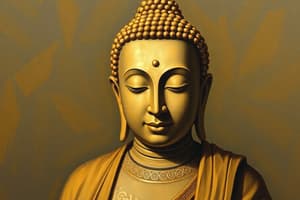Podcast
Questions and Answers
What were the two major religions that emerged from the teachings of Gautama Buddha and Vardhmana Mahavira?
What were the two major religions that emerged from the teachings of Gautama Buddha and Vardhmana Mahavira?
Buddhism and Jainism.
What significant event prompted Siddhartha to leave his life as a prince and seek enlightenment?
What significant event prompted Siddhartha to leave his life as a prince and seek enlightenment?
Seeing an old man, a sick man, a dead corpse, and a monk.
Where did Gautama Buddha attain enlightenment?
Where did Gautama Buddha attain enlightenment?
Under the Mahabodhi tree in Bodh Gaya.
At what age did Siddhartha leave his palace to become a monk?
At what age did Siddhartha leave his palace to become a monk?
What is the name of Buddha's first sermon and where was it delivered?
What is the name of Buddha's first sermon and where was it delivered?
What are the Four Noble Truths in Buddhism?
What are the Four Noble Truths in Buddhism?
What is the significance of the Eightfold Path in Buddhism?
What is the significance of the Eightfold Path in Buddhism?
How did Buddhism divide during Kanishka's reign?
How did Buddhism divide during Kanishka's reign?
Who is considered the founder of Jainism and what title does he hold?
Who is considered the founder of Jainism and what title does he hold?
What was the early life of Mahavira like and who were his parents?
What was the early life of Mahavira like and who were his parents?
Flashcards are hidden until you start studying
Study Notes
Buddhism
- Founded around the 6th century BCE by Gautama Buddha
- Spread from India to Central Asia, Sri Lanka, Tibet, Southeast Asia, China, Korea and Japan
- Buddha's real name was Siddhartha
- Born into the Shakya Gana, a Kshatriya clan
- Born in Kapilavasna in 563 BC
- Father was Shuddodhana, chief of the Shakya Gana
- Mother Mahamaya died soon after birth
- Raised by his aunt, Mahaprajapati
- A seer predicted he would become either a great king or saint
- Father shielded him from religion and suffering to ensure he became a great king
- Married to Yashodhara at age 16
- Yashodhara gave birth to a son, Rahula
- Left his palace at age 29 to become a monk
- Wandered for years before meditating under a pipal tree in Gayajand
- Attained enlightenment after many days of meditation, becoming the Buddha
- The pipal tree became known as the Mahabodhi tree
- Preached his first sermon at Sarnath (near Varanasi), known as the Dharmachakra Pravartana
- Died at age 80 in 483 BCE at Kushinagara, Uttar Pradesh
Teachings of Buddha
- Explained in the Four Noble Truths and the Eightfold Path
- Four Noble Truths
- The world is full of suffering.
- The cause of suffering is desire.
- Ending suffering requires eliminating desire.
- Eliminating desire requires following the Eightfold Path.
- Eightfold Path
- Right thought
- Right speech
- Right action
- Right livelihood
- Right effort
- Right mindfulness
- Right meditation
- Right understanding
- Following the path purifies the mind and helps attain Nirvana
- Emphasized ahimsa (non-violence) with pure thought, speech, and action
- Criticized the caste system
- Stressed love and compassion for all beings
Religious Texts
- Buddha's teachings are compiled in the Tripitakas (three baskets)
- Written in Pali
- Other texts include the Jataka Tales, which tell stories from Buddha's birth and previous lives
Spread of Buddhism
- Emperor Kanishka divided Buddhism into two sects
- Hinayana (Lesser Vehicle) – followed Buddha's teachings strictly
- Mahayana (Greater Vehicle) – believed Buddha was an incarnation of God
- Spread due to simple teachings expressed in Prakrit
- Promoted by emperors Ashoka and Kanishka
Jainism
- Founded by Rishabhadeva
- Mahavira is considered the last Tirthankara (preacher) in a line of 24
- Rishabhadeva was the first Tirthankara, also known as Adinath
Early Years of Mahavira
- Born in 540 BCE at Kundagrama in Vaishali (Bihar).
- Father was Siddhartha, head of the Jnatrika clan.
- Mother was Trishala, a Lichhavi princess.
- Married to a princess named Yashoda, had a daughter named Priyadarsena.
- Gave up his princely status at age 30 to become an ascetic.
- Wandered for 12 years before attaining enlightenment
- Called 'Mahavira' or 'Jina' (conqueror)
- Followers are called Jains
- Many rulers, including Kharavela and Chandragupta Maurya followed Jainism
- Died in 468 BCE at Pavapuri near modern Rajgir (Bihar)
Teachings of Mahavira
- Believed in leading a simple life
- Against rituals and animal sacrifices
- Emphasized ahimsa (non-violence)
- Believed animals and plants have souls, so causing harm to any living thing was wrong
- Attaining moksha (freedom from the cycle of rebirth) was the main goal
- Achieve this through the triratnas (three jewels of life):
- Right faith
- Right knowledge
- Right action
- Jainism aims to free individuals from worldly bonds
- Five main doctrines:
- Do not commit violence
- Do not speak a lie
- Do not steal
- Do not acquire property
- Observe continence (nigraha)
- Did not believe in the varna system, treated all men as equal
Jainism: Later Divisions
- Divided into two sects:
- Digambaras (Sky-clad): observed long fasts, wore no clothes
- Swetambaras (White-clad): more liberal, wore white clothes
- Spread from Orissa in the east to Gujarat in the west and south as far as Mysore
- Also spread to Gujarat and Rajasthan (Swetambara sect), and Karnataka and Andhra Pradesh (Digambara sect)
- Teachings were delivered in Prakrit
- Religious texts were written in Ardh-magadhi, a form of Prakrit
The Sangha
- Founded by Gautama Buddha in the 5th century BCE
- Means 'assembly' or 'community', refers to Buddhist or Jain groups
- Established to spread the message of Buddha
- Open to even Shudras
- Both Buddha and Mahavira believed leaving home was necessary for true knowledge
- Rules for the Buddhist Sangha were written in the Vinayapitaka
- All men could join, but children needed parental permission and women needed their husbands' permission
- Only emancipated slaves could join
- Led simple lives, meditating and begging for food
- Taught others and helped each other
- Sangha members included Brahmins, Kshatriyas, merchants, and slaves
Panini - The Grammarian
- Prepared a grammar in Sanskrit during this period
- Arranged vowels and consonants in a special order, creating formulae
- Wrote down grammar rules (around 3000) based on these formulae
Viharas
- Monasteries established by Buddha
- Buddhaist monks (Bhikkhus) lived in viharas
- Viharas were centers of education
- As supporters sought more permanent shelters, viharas were constructed of wood and brick
- Some were built in caves dug into hills in western India
Upanishads
- Hindu thinkers discussed new ideas about Atman (individual soul) and Brahman (universal soul)
- Raised questions about life, death, and the need for sacrifices
- Their ideas were recorded in the Upanishads
- Most Upanishadic thinkers were men, especially Brahmin and Raja
- Few women participated in discussions, such as Gargi, who was famous for her learning
- Poor people rarely participated, with Satyaka being one exception
- He was accepted by a Brahmin teacher named Gautama and became a leading thinker
- Many of the ideas in the Upanishads were later developed by Shankaracharya
- 'Upanishad' means 'to sit at the feet of the Guru to receive teaching'
- The main topic is ultimate knowledge: the identity of Brahman and Atman
- These philosophical texts criticized rituals and emphasized right belief and knowledge
- 108 Upanishads exist, 13 being the main ones
- Written between 8th and 4th century BCE
- Written in Sanskrit
Studying That Suits You
Use AI to generate personalized quizzes and flashcards to suit your learning preferences.




